May 30th, 2012 Both the French and the Germans were intrigued with Russian military uniforms and with good reason (see the image below). But one would think the tassels and plumes and chinstraps would have slowed a guy down and made him want to scratch rather than fight. And imagine the combatants’ manly gossip: “Tsk tsk, Yuri’s frockcoat is full of moth holes and he doesn’t know his shako from his kepi.”
![C5407 Image from Armee francaise et armee Rusee [1886?]](http://blogs.lib.ku.edu/spencer/wp-content/uploads/2012/04/C5407.jpg)
Armée française et armée russe. Paris: A. Taride, [1886?] Call Number: C5407
When Peter I created a standing army early in the 18th century he introduced standard uniforms for each branch. These uniforms evolved through the decades with each change of the guard, most starting out quite complicated and later becoming simpler and more comfortable. But how much time and energy was spent just getting fitted for these elaborate get-ups? And since the purpose of the covering was to distinguish the enemy from the fellow-traveler, how much fashion schooling did a soldier need not to take out his brother with friendly fire? Indeed sometimes the designs backfired when the color of a coat in certain terrain exposed its wearer on the battlefield. Camouflage became the order of the day in the early 20th century: 1904 in Britain, 1906 in Russia, but not until 1908 in the USA. WWI saw the re-appearance of metal headgear: the steel helmet, but the Soviets didn’t begin wearing it until the 1930s. As for hair, compare the powdered wigs of officers and the braids of infantrymen under Paul I of Russia (1796-1801) with the buzz cuts of today.
In the Kenneth Spencer Research Library’s collections is an Austrian publication with equally attractive plates, Die Russische Armee im Felde, Wien: [s. n.] 1888, (call number: B5201).
Sally Haines
Rare Books Cataloger
Adapted from her Spencer Research Library exhibit, Frosted Windows: 300 Years of St. Petersburg Through Western Eyes.
Tags: Armée française et armée russe, Military Uniforms, Russia, Sally Haines
Posted in Exhibitions, Special Collections |
No Comments Yet »
May 24th, 2012 Easter Sunday … after dinner they brought us an enormous sort of cake to look at – it is made of flour, lard, cheese, & quantities of eggs – the name is Pizza – or Torta – one of these we saw must have been 4 feet in circumference – it is made at Easter – only in this part of the country not in Rome – it is rather good – very light – but too strong of the cheese – they eat this cake – sausages – eggs which have been blessed (so has the cake) and wash it down with the best wine which is stored up for the occasion – such is their Easter feast. …
Entered by Pauline Trevelyan in her diary, Spoleto, Italy, 27 March 1842 , call number: MS C133
Traditional pizza recipes vary greatly in different regions of Italy. In her journal entry for Easter Sunday 1842 Pauline Trevelyan describes her first taste of Umbrian Easter pizza, a tall round loaf of cheese-flavored bread traditionally served with sliced Italian sausage and hard-boiled eggs. The photograph featured below shows the tasty recreation of that meal submitted to the recent University of Kansas Libraries edible book competition.
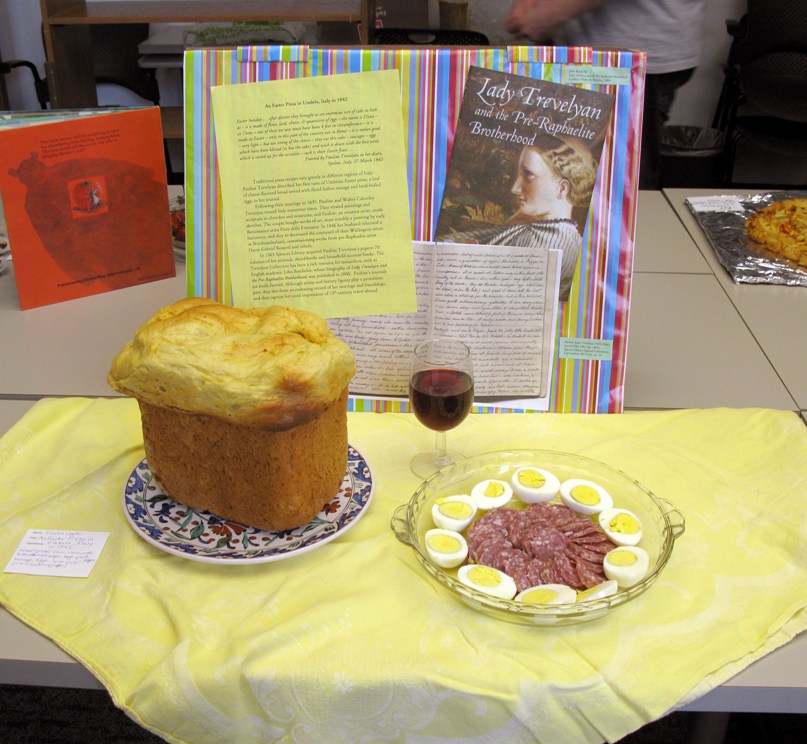 Read the rest of this entry »
Read the rest of this entry »
Tags: 19th Century, Italy, Karen S. Cook, Lady Pauline Trevelyan, pizza, travel diary, Walter Calverley Trevelyan
Posted in Special Collections |
No Comments Yet »
May 22nd, 2012 In Medieval Europe books were a precious commodity. Books were hand-copied manuscripts, and might be fashioned with metal hardware to chain them to a bookcase or desk to protect them from theft.
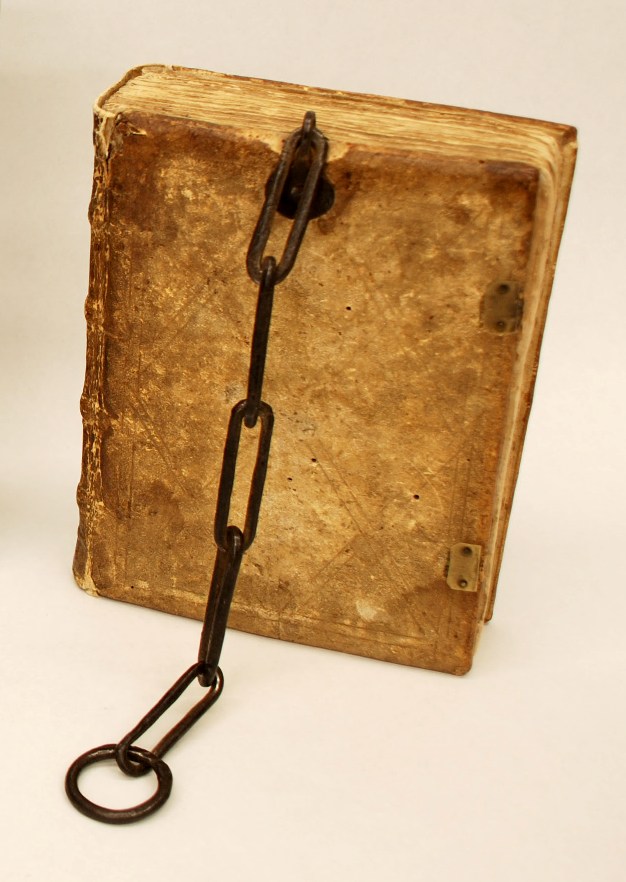
Sermones de sanctis by Frater Soccus. [Germany?] ca. 1370. Call Number: MS D84
This book is a bound manuscript likely from Germany, dated circa 1370. The text is Sermones de sanctis (call number: MS D84), writings of Frater Soccus, a monk from the Cistercian order. The pigskin binding, tooled all over the covers, has a chain attached to the back board at the top. Storing this on a modern shelf created problems, as the chain drapes down the back cover and makes it impossible to place another book next to it. Read the rest of this entry »
Tags: chained books, chained library, clamshell box, conservation treatments, Frater Soccus, medieval bindings, medieval manuscripts, protective enclosures, Sermones de sanctis, Whitney Baker
Posted in Conservation, Special Collections |
No Comments Yet »
May 18th, 2012 Did you know that the Kenneth Spencer Research Library has a KU-themed Monopoly game or a memory game created by Mark Twain? Come see the diversity of the Spencer Library’s collections presented in a new exhibition entitled “Riddle Me This: A History of Games and Puzzles.”
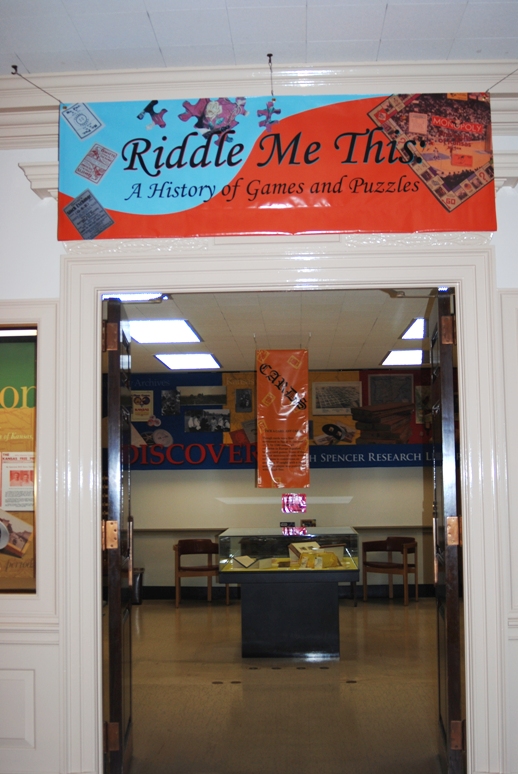
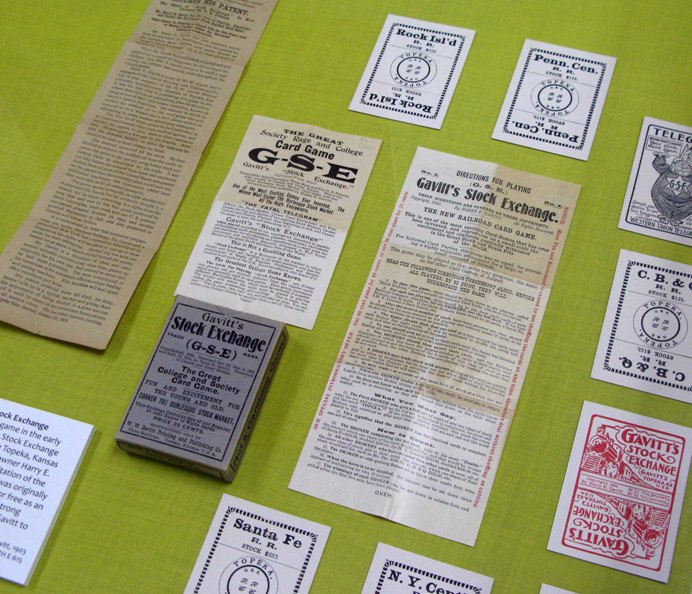
“Riddle Me This” exhibition. Right: Gavitt’s Stock Exchange (G-S-E).
Topeka, Kan.: W.W. Gavitt Printing and Publishing Co., 1903. Call number: RH E615
Read the rest of this entry »
Tags: Ashley Sharratt, board games, cards, exhibition, Gavitt’s Stock Exchange, Gillian Armstrong, Jami Roskamp, Megan Perez, Melissa Doebele, puzzles, word games
Posted in Events, Exhibitions, Kansas Collection, Special Collections, University Archives |
No Comments Yet »
May 15th, 2012 As Robert Taft explains in his history of KU, Across the Years on Mount Oread, the first May-pole scrap occurred on May 1, 1891. The preceding night, the junior class had erected a pole forty feet high in front of old Fraser (then known as University Hall), and on the pole was a banner marked with the figures, ’92. The pole was found on the ground the next morning with a sophomore wielding an axe beside it. The juniors, aided by a group of freshman, tried to regain the pole and banner, but the seniors came to the rescue of the sophomores and together they burned the banner. The battle raged into the evening and the “May-pole scrap” was born. This battle between freshman and sophomores continued for nearly fifteen years as an annual event and eventually developed into a series of duels that were not confined to May-day alone. The May-pole scrap was discontinued by 1905 because of the violent nature of this KU tradition.
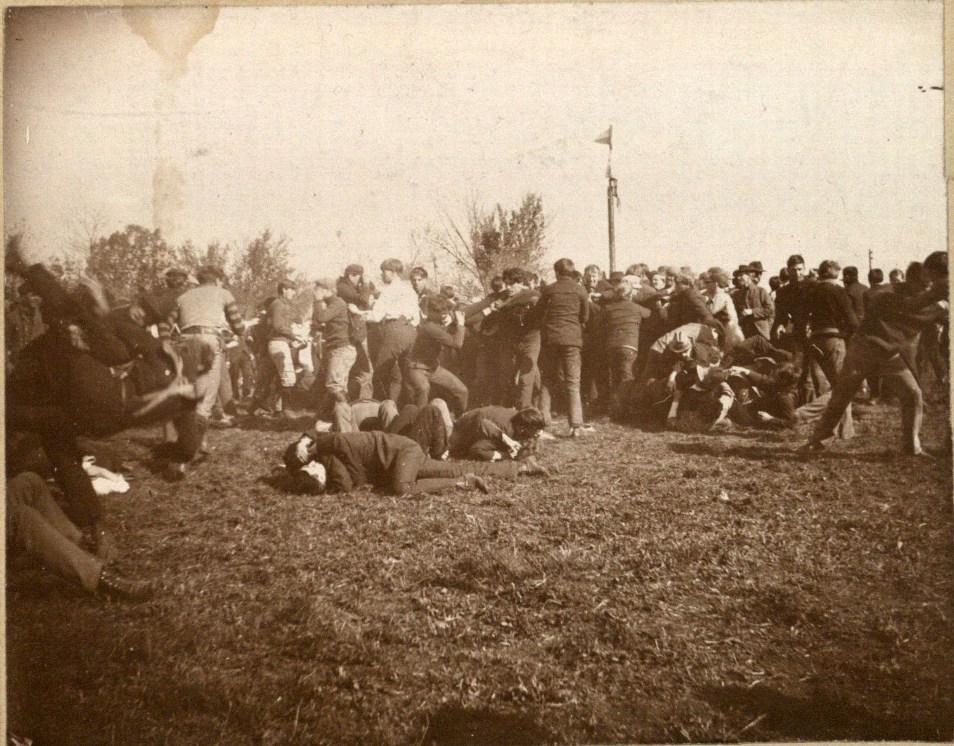
1904 May-pole Scrap between the freshman and sophomore classes to determine whose colors would be hoisted on the May pole. May Day Photographs, Call Number: 71/10/1904
In its place a new tradition was established, the May Fête. Read the rest of this entry »
Tags: Becky Schulte, early 20th century, KU History, May Fête, May-pole scrap, photographs, University of Kansas
Posted in University Archives |
No Comments Yet »

![C5407 Image from Armee francaise et armee Rusee [1886?]](http://blogs.lib.ku.edu/spencer/wp-content/uploads/2012/04/C5407.jpg)




